Abstract
The influences of smoking and age on the elimination kinetics of disopyramide were studied in 27 subjects. Total elimination clearance of disopyramide was measured after an infusion to steady state. The total elimination clearance was significantly (P less than 0.05) decreased in elderly non-smoking patients compared with young non-smoking subjects (1.54 +/- 0.33 vs 2.12 +/- 0.67 ml kg-1 min-1) (mean +/- s.d.). Smoking more than 20 cigarettes per day significantly (P less than 0.05) increased total elimination clearance in elderly (2.02 +/- 0.35 vs 1.54 +/- 0.33 ml kg-1 min-1), while no significant induction by tobacco was observed in young healthy persons. Serum concentrations of alpha 1-acid glycoprotein, the major binding protein of disopyramide, were significantly higher (P less than 0.001) in the elderly patients. However, the volume of distribution (V) was significantly (P less than 0.001) greater in the elderly patients (2.44 +/- 0.64 vs 1.16 +/- 0.15 1 kg-1). Steady-state serum concentrations of the free drug were significantly (P less than 0.01) lower in the young volunteers (0.75 +/- 0.13 micrograms ml-1) than in the elderly (0.90 +/- 0.10 micrograms ml-1). The half-life of disopyramide was significantly shorter (P less than 0.01) in the young volunteers than in the elderly patients. No difference was observed in the relationship between the serum concentration of disopyramide and its main dealkylated metabolite in the groups studied. The results indicate that it might be advisable to reduce the dosage of disopyramide by approximately 30% in elderly non-smokers compared with young subjects.
Full text
PDF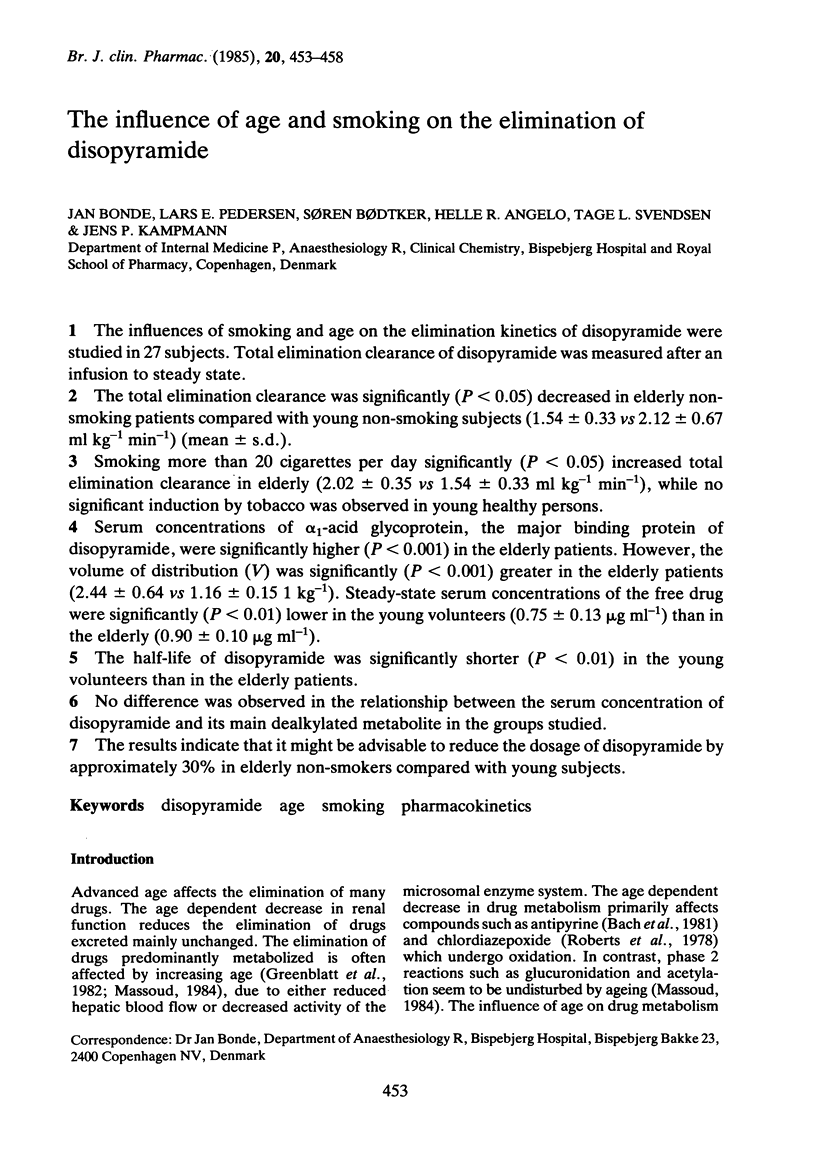
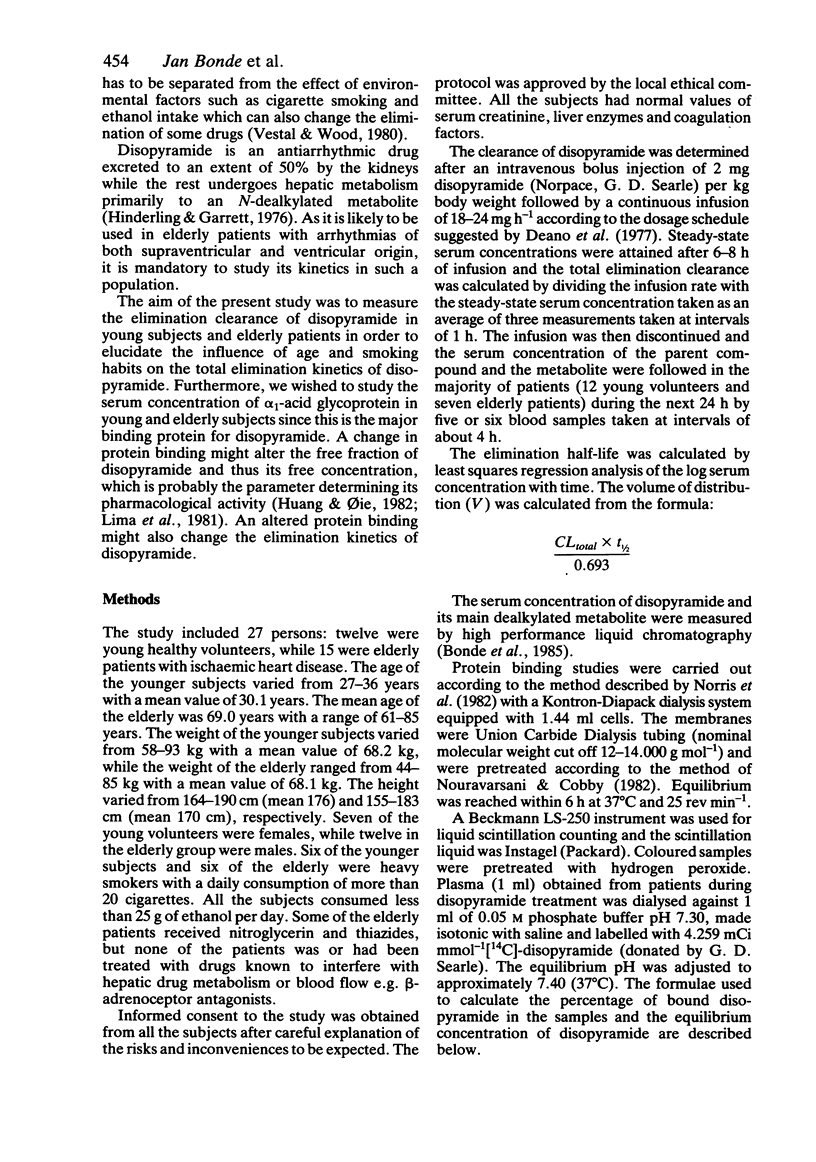
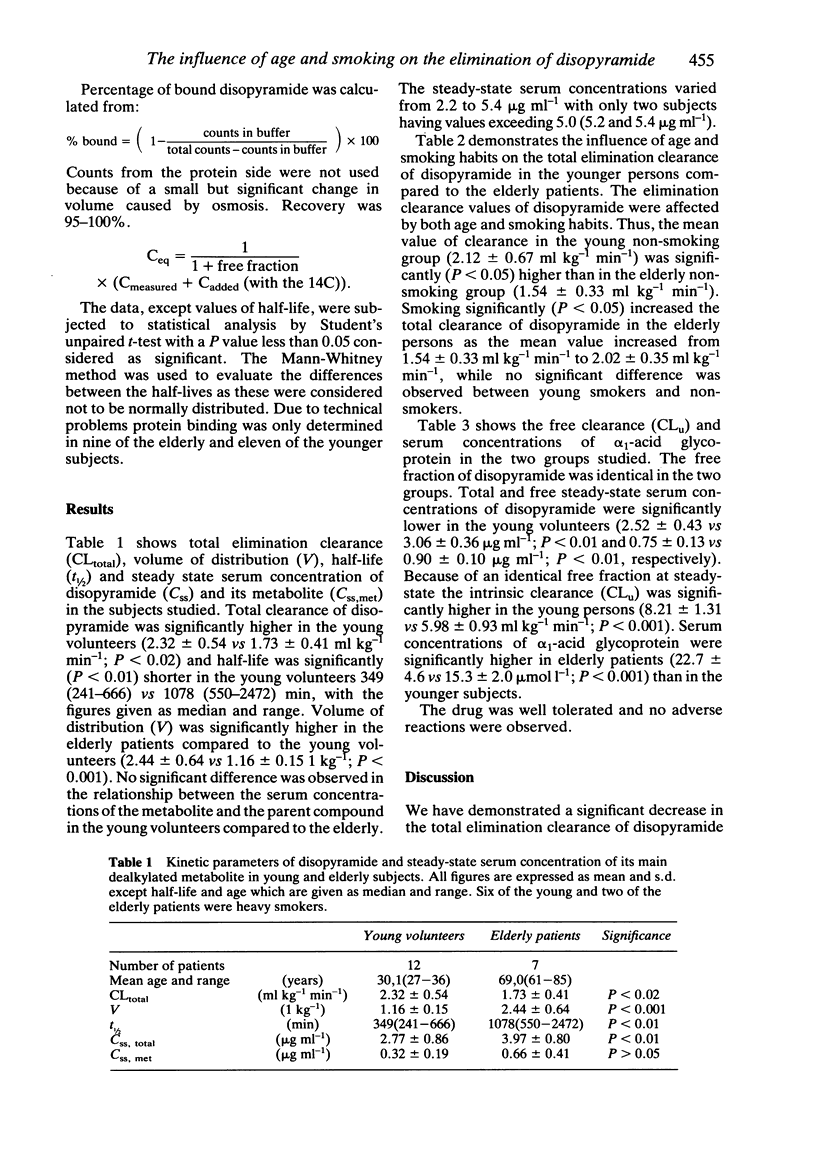
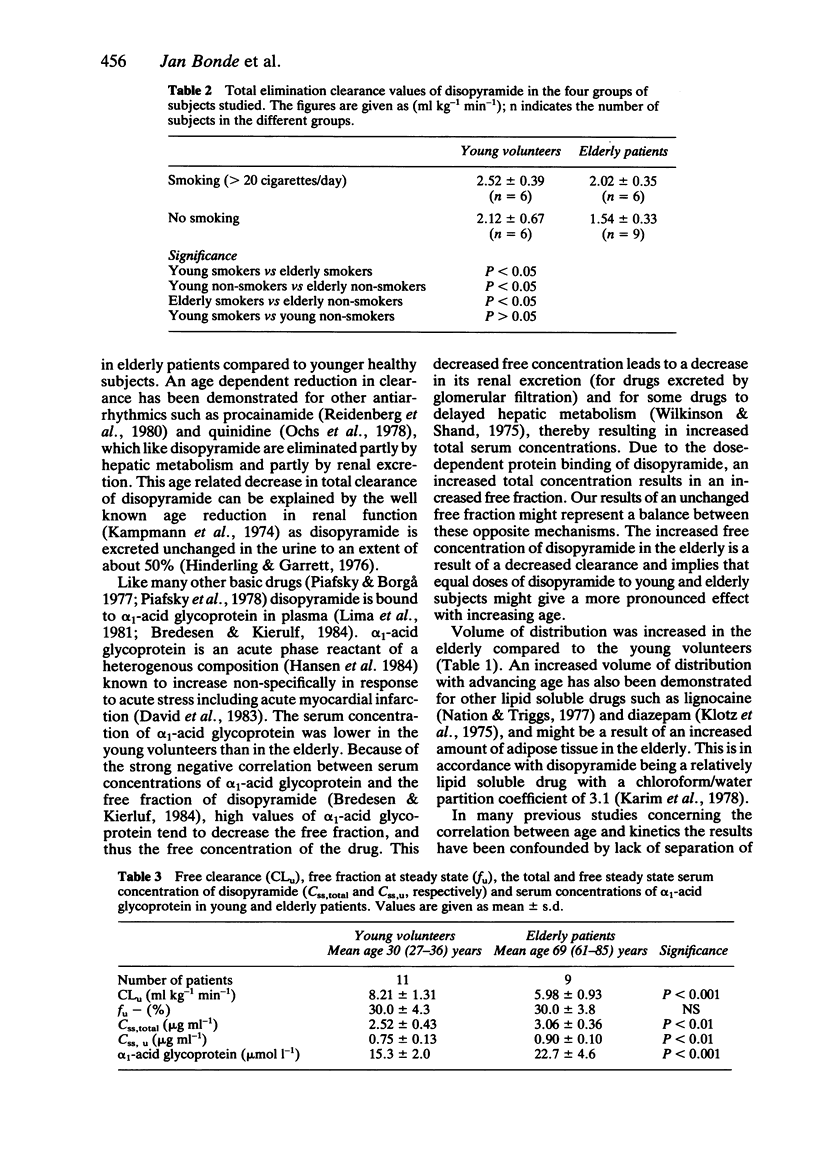
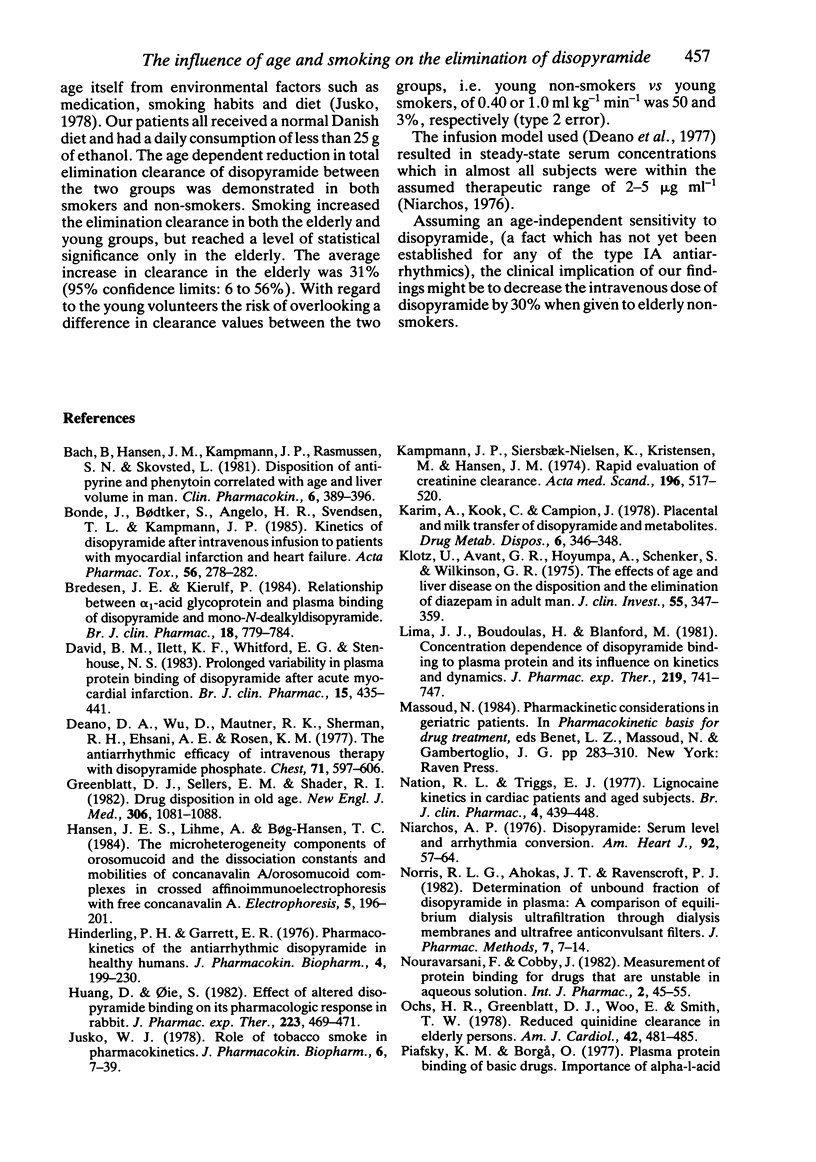
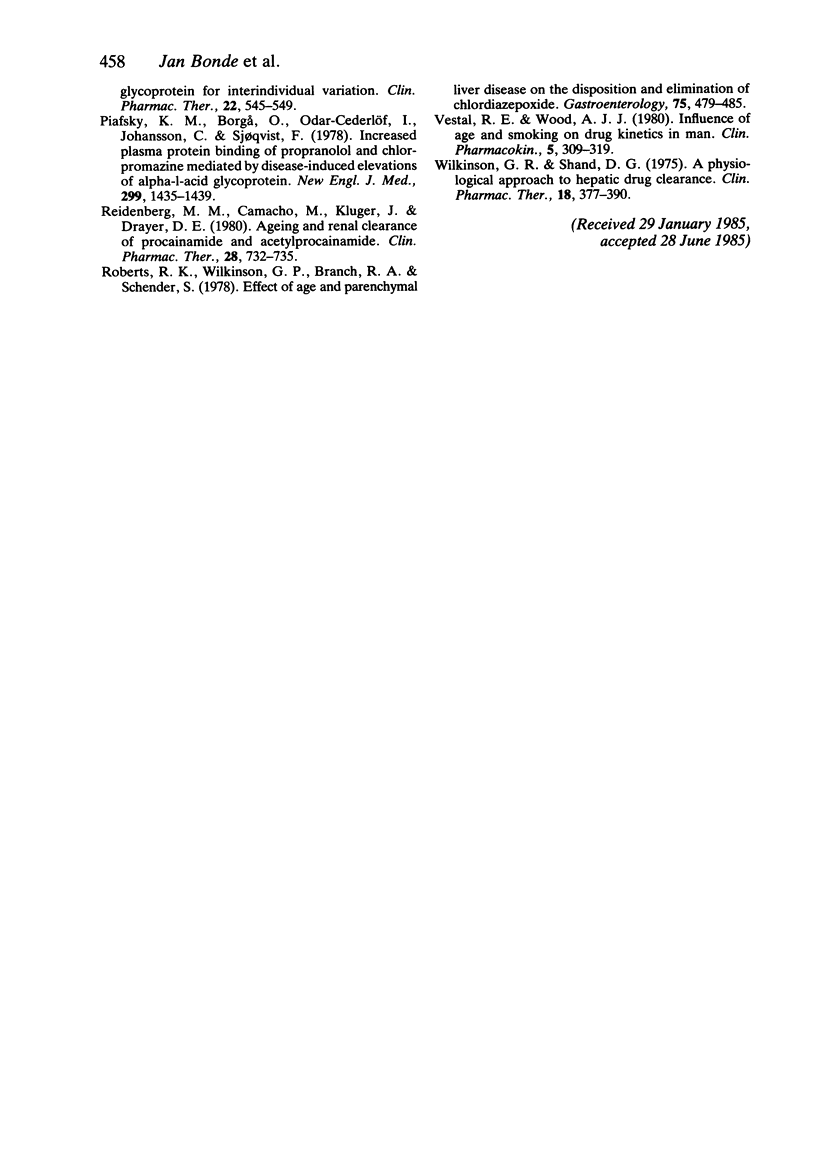
Selected References
These references are in PubMed. This may not be the complete list of references from this article.
- Bach B., Hansen J. M., Kampmann J. P., Rasmussen S. N., Skovsted L. Disposition of antipyrine and phenytoin correlated with age and liver volume in man. Clin Pharmacokinet. 1981 Sep-Oct;6(5):389–396. doi: 10.2165/00003088-198106050-00005. [DOI] [PubMed] [Google Scholar]
- Bonde J., Angelo H. R., Bødtker S., Svendsen T. L., Kampmann J. P. Kinetics of disopyramide after intravenous infusion to patients with myocardial infarction and heart failure. Acta Pharmacol Toxicol (Copenh) 1985 Apr;56(4):278–282. doi: 10.1111/j.1600-0773.1985.tb01290.x. [DOI] [PubMed] [Google Scholar]
- Bredesen J. E., Kierulf P. Relationship between alpha 1-acid glycoprotein and plasma binding of disopyramide and mono-N-dealkyldisopyramide. Br J Clin Pharmacol. 1984 Nov;18(5):779–784. doi: 10.1111/j.1365-2125.1984.tb02542.x. [DOI] [PMC free article] [PubMed] [Google Scholar]
- David B. M., Ilett K. F., Whitford E. G., Stenhouse N. S. Prolonged variability in plasma protein binding of disopyramide after acute myocardial infarction. Br J Clin Pharmacol. 1983 Apr;15(4):435–441. doi: 10.1111/j.1365-2125.1983.tb01527.x. [DOI] [PMC free article] [PubMed] [Google Scholar]
- Deano D. A., Wu D., Mautner R. K., Sherman R. H., Ehsani A. I., Rosen K. M. The antiarrhythmic efficacy of intravenous therapy with disopyramide phosphate. Chest. 1977 May;71(5):597–606. doi: 10.1378/chest.71.5.597. [DOI] [PubMed] [Google Scholar]
- Greenblatt D. J., Sellers E. M., Shader R. I. Drug therapy: drug disposition in old age. N Engl J Med. 1982 May 6;306(18):1081–1088. doi: 10.1056/NEJM198205063061804. [DOI] [PubMed] [Google Scholar]
- Hinderling P. H., Garrett E. R. Pharmacokinetics of the antiarrhythmic disopyramide in healthy humans. J Pharmacokinet Biopharm. 1976 Jun;4(3):199–230. doi: 10.1007/BF01063614. [DOI] [PubMed] [Google Scholar]
- Huang J. D., Oie S. Effect of altered disopyramide binding on its pharmacologic response in rabbits. J Pharmacol Exp Ther. 1982 Nov;223(2):469–471. [PubMed] [Google Scholar]
- Jusko W. J. Role of tobacco smoking in pharmacokinetics. J Pharmacokinet Biopharm. 1978 Feb;6(1):7–39. doi: 10.1007/BF01066061. [DOI] [PubMed] [Google Scholar]
- Kampmann J., Siersbaek-Nielsen K., Kristensen M., Hansen J. M. Rapid evaluation of creatinine clearance. Acta Med Scand. 1974 Dec;196(6):517–520. doi: 10.1111/j.0954-6820.1974.tb01053.x. [DOI] [PubMed] [Google Scholar]
- Karim A., Kook C., Campion J. Placental and milk transfer of disopyramide and metabolites. Drug Metab Dispos. 1978 May-Jun;6(3):346–348. [PubMed] [Google Scholar]
- Klotz U., Avant G. R., Hoyumpa A., Schenker S., Wilkinson G. R. The effects of age and liver disease on the disposition and elimination of diazepam in adult man. J Clin Invest. 1975 Feb;55(2):347–359. doi: 10.1172/JCI107938. [DOI] [PMC free article] [PubMed] [Google Scholar]
- Lima J. J., Boudoulas H., Blanford M. Concentration-dependence of disopyramide binding to plasma protein and its influence on kinetics and dynamics. J Pharmacol Exp Ther. 1981 Dec;219(3):741–747. [PubMed] [Google Scholar]
- Nation R. L., Triggs E. J., Selig M. Lignocaine kinetics in cardiac patients and aged subjects. Br J Clin Pharmacol. 1977 Aug;4(4):439–448. doi: 10.1111/j.1365-2125.1977.tb00759.x. [DOI] [PMC free article] [PubMed] [Google Scholar]
- Niarchos A. P. Disopyramide: serum level and arrhythmia conversion. Am Heart J. 1976 Jul;92(1):57–64. doi: 10.1016/s0002-8703(76)80403-6. [DOI] [PubMed] [Google Scholar]
- Norris R. L., Ahokas J. T., Ravenscroft P. J. Determination of unbound fraction of disopyramide in plasma: a comparison of equilibrium dialysis, ultrafiltration through dialysis membranes and ultrafree anticonvulsant drug filters. J Pharmacol Methods. 1982 Jan;7(1):7–14. doi: 10.1016/0160-5402(82)90053-5. [DOI] [PubMed] [Google Scholar]
- Ochs H. R., Greenblatt D. J., Woo E., Smith T. W. Reduced quinidine clearance in elderly persons. Am J Cardiol. 1978 Sep;42(3):481–485. doi: 10.1016/0002-9149(78)90944-x. [DOI] [PubMed] [Google Scholar]
- Piafsky K. M., Borgá O., Odar-Cederlöf I., Johansson C., Sjöqvist F. Increased plasma protein binding of propranolol and chlorpromazine mediated by disease-induced elevations of plasma alpha1 acid glycoprotein. N Engl J Med. 1978 Dec 28;299(26):1435–1439. doi: 10.1056/NEJM197812282992604. [DOI] [PubMed] [Google Scholar]
- Piafsky K. M., Borgå O. Plasma protein binding of basic drugs. II. Importance of alpha 1-acid glycoprotein for interindividual variation. Clin Pharmacol Ther. 1977 Nov;22(5 Pt 1):545–549. doi: 10.1002/cpt1977225part1545. [DOI] [PubMed] [Google Scholar]
- Reidenberg M. M., Camacho M., Kluger J., Drayer D. E. Aging and renal clearance of procainamide and acetylprocainamide. Clin Pharmacol Ther. 1980 Dec;28(6):732–735. doi: 10.1038/clpt.1980.228. [DOI] [PubMed] [Google Scholar]
- Roberts R. K., Wilkinson G. R., Branch R. A., Schenker S. Effect of age and parenchymal liver disease on the disposition and elimination of chlordiazepoxide (librium). Gastroenterology. 1978 Sep;75(3):479–485. [PubMed] [Google Scholar]
- Vestal R. E., Wood A. J. Influence of age and smoking on drug kinetics in man: studies using model compounds. Clin Pharmacokinet. 1980 Jul-Aug;5(4):309–319. doi: 10.2165/00003088-198005040-00001. [DOI] [PubMed] [Google Scholar]
- Wilkinson G. R., Shand D. G. Commentary: a physiological approach to hepatic drug clearance. Clin Pharmacol Ther. 1975 Oct;18(4):377–390. doi: 10.1002/cpt1975184377. [DOI] [PubMed] [Google Scholar]


